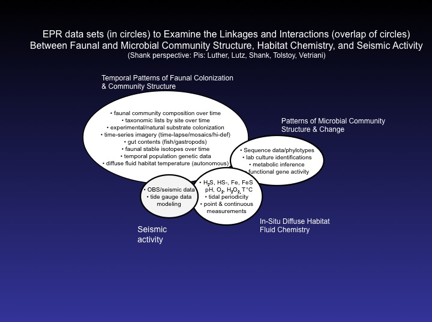Shank
Long-Term Integrated Studies on the East Pacific Rise: Spatial and Temporal Patterns of Interactions Among Vent Fluid Chemistry, Microbial Community Structure and Faunal Colonization Associated with Volcanic Disturbances
T.M. Shank¹*, B. Govenar¹, G.W. Luther², C. Vetriani³, S. Sievert¹, L. Gulman¹, W.E. Seyfried⁴, D.J. Fornari⁵, M. Tolstoy⁶, & R.A. Lutz³
Corresponding author: tshank@whoi.edu
¹Woods Hole Oceanographic Institution, Biology Department, Woods Hole, MA, 02543
²University of Delaware, Name of Department, Lewes, DE,19958
³Rutgers University, Institute of Marine and Coastal Sciences, New Brunswick, NJ, 09894
⁴University of Minnesota, Geology and Geophysics Department, Minneapolis, MN, 55455
⁵Woods Hole Oceanographic Institution, Geology and Geophysics Department, Woods Hole, MA, 02543
⁶Lamont Doherty Earth Observatory, Columbia University, Palisades, NY 10964-8000
Abstract:
Our integrated approach has been aimed at understanding biological-geochemical interactions and the coupling of microbial and faunal succession of basalt at deep-sea hydrothermal vents. For the past 16 years, we have systematically conducted chemical, temperature, and microbial surveys in diffuse flow vent habitats occupied by different foundation species (i.e., Riftia and Tevnia tubeworms and bathymodiolin mussels), examined habitat variability using autonomous in-situ chemical sensors in association with faunal and microbial sampling, and examined these processes using digital time-lapse camera systems and manipulative field experiments. Through the use of natural and artificial settlement substrates, we have documented differences in vent fluid chemistry co-incident with the development of microbial biofilms and the subsequent settlement of certain invertebrate species. Specifically, on our colonization substrates, TAMS (Temporal Autonomous Multi-disciplinary Substrates), deployed after the 2005-06 eruption, we identified patterns in the settlement of tubeworms and mussels, coincident with changes in fluid chemistry and temperature, with marked differences in short-term (days to months) microbial community development. Our long-term studies provide an ideal framework for studies of the spatial and temporal variability of the processes that structure biological communities, including to the extent that they are governed by the processes underlying large-scale volcanic disturbance and small-scale changes in fluid flux and microbial activity. As such, we now seek integrative models to parameterize the biological-geochemical patterns and processes of community succession that are consistent with our empirical observations.
Contributions to Integration and Synthesis:
Our approach has focused on understanding how biological processes in the region impact, and are impacted by, hydrothermal fluid chemistry and microbial biofilm composition, which is the expression of energy through mantle-rock-water interaction. Such studies are central to the R2K Implementation Plan for the EPR Integrated Studies Site (ISS). Our study area is focused within the “bull’s-eye” (9°49' - 9°51'N) and associated with two volcanic eruptions and other inferred disturbances. The infrastructure and scientific objectives of our study complement: (1) OBS networks (Tolstoy et al. 2006), ideal for integrating the identification of biological responses to observed seismic activity; (2) high-temperature fluid (time-series) sampling studies (K. Von Damm; J. Bryce), ideal for integrating changes in reaction zone depth with our documented changes in diffuse fluid chemistry; and (3) concurrent hydrographic circulation surveys /larval transport modeling (L. Mullineaux & Ladder PIs), ideal for integrating our observed patterns of successful larval colonization with the observed current patterns/modeling. To maximize active interaction and integration with our multi-disciplinary data, we have coordinated our recent (2005-2007) experimental design with seismologists and chemists working at the EPR ISS and have focused our integrated habitat characterization, in situ chemistry, and colonization studies on discrete vent fields and regions.
Figures:
Figure 1. EPR data sets (in circles) to examine the linkages and interactions (overlap of circles) between faunal and microbial community structure, habitat chemistry, and seismic activity. Shank_fig1.jpg

